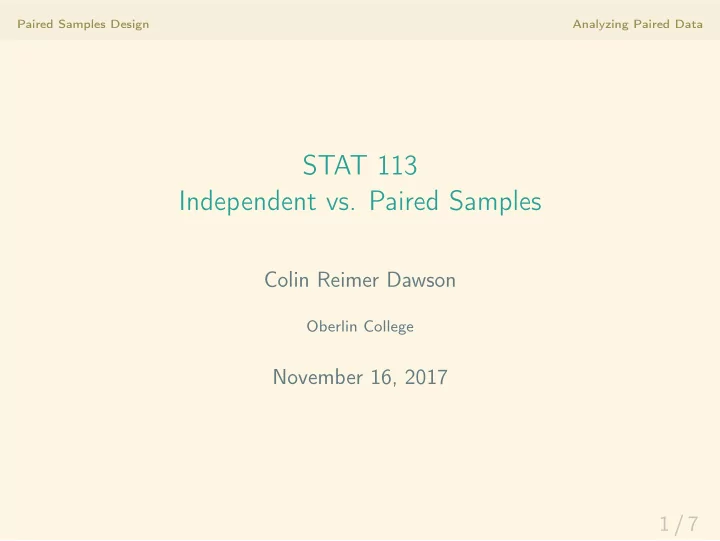

Paired Samples Design Analyzing Paired Data STAT 113 Independent vs. Paired Samples Colin Reimer Dawson Oberlin College November 16, 2017 1 / 7
Paired Samples Design Analyzing Paired Data Paired Samples Design Analyzing Paired Data 2 / 7
Paired Samples Design Analyzing Paired Data Outline Paired Samples Design Analyzing Paired Data 3 / 7
Paired Samples Design Analyzing Paired Data Independent Groups Vs. Paired Samples Design • Independent Groups: Randomly assign cases to groups (or get two groups, in observational study) • Random Assignment: Removes systematic differences between groups • However, still have chance differences between groups. • Chance differences are a source of sample-to-sample variability that we need to account for in CIs and tests. • Paired Samples: Each observation in group A has a matched (similar) observation in group B • Removes some chance differences between groups • Reduces sample-to-sample variability • Narrower CIs • Easier to reject H 0 (given difference less likely to be caused by chance) 4 / 7
Paired Samples Design Analyzing Paired Data Kinds of Paired Samples Designs 1. Repeated Measures Design: Each case produces an observation in each group. 2. Matched Pairs Design: Observations come from different sources (e.g., people), but cases are selected to be similar in key ways (e.g., identical twins that share genetics; or pairs matched by gender, race, age, etc.) 3. Pairing By Time : Alternate cases between groups so that pairs were collected close in time (e.g., b/c you think time of day / week / year / etc. is a source of variability) 5 / 7
Paired Samples Design Analyzing Paired Data Outline Paired Samples Design Analyzing Paired Data 6 / 7
Paired Samples Design Analyzing Paired Data Analyzing Paired Data: Convert to One Sample • In a paired samples design, can convert from two sets of original response variable to a single set of difference scores . Then • Parameter: µ D , population mean difference score • Hypotheses H 0 : µ D = 0 , H 1 : µ D � = 0 (or > 0 or < 0 ) • CI: µ D between A and B with some confidence • As one sample: Sampling distribution is t , with n D − 1 df ( n D is the number of pairs ), provided (a) n D large, and/or (b) population of differences is approx. Normal 7 / 7
Recommend
More recommend